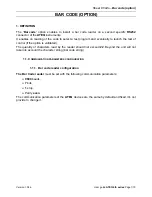
Chapter 6
78
Using software, you can stop a scan by performing either an orderly stop or an abrupt
stop. In an orderly stop, the board finishes acquiring the specified number of samples,
stops all subsequent acquisition, and transfers the acquired data to host memory; all
subsequent triggers or retriggers are ignored. In an abrupt stop, the board stops acquiring
samples immediately; the acquired data is not transferred to host memory, but all
subsequent triggers or retriggers are ignored.
Continuously-Paced Scan Mode
Use continuously-paced scan mode if you want to accurately control the period between
conversions of individual channels in a scan.
When it detects an initial trigger, the board cycles through the channel list, acquiring and
converting the value for each entry in the channel list (this process is defined as the scan). The
board then wraps to the start of the channel list and repeats the process continuously until
either the allocated buffers are filled or until you stop the operation. Refer to
information on buffers.
The conversion rate is determined by the frequency of the A/D sample clock; refer to
for more information on the A/D sample clock. The sample rate, which is the rate at which a
single entry in the channel list is sampled, is determined by the frequency of the A/D sample
clock divided by the number of entries in the channel list.
To select continuously-paced scan mode, use software to specify the dataflow as continuous,
continuous pre-trigger, or continuous about-trigger (sometimes called continuous pre-post
trigger). The initial trigger source depends on the trigger acquisition mode you use. Refer to
for more information on the supported trigger sources and trigger acquisition modes.
Triggered Scan Mode
DT300 Series boards support two triggered scan modes: software- retriggered and
externally-retriggered. These modes are described in the following subsections.
Software-Retriggered Scan Mode
Use software-retriggered scan mode if you want to accurately control both the period between
conversions of individual channels in a scan and the period between each scan. This mode is
useful when synchronizing or controlling external equipment, or when acquiring a buffer of
data on each trigger or retrigger. Using this mode, you can acquire up to 262,144 samples per
trigger (256 times per trigger x 1024-location channel list).
When it detects an initial trigger, the DT300 Series board scans the channel list a specified
number of times (up to 256), then waits for an software retrigger to occur. When it detects the
software retrigger, the board scans the channel list the specified number of times, then waits
for another software retrigger to occur. The process repeats continuously until either the
allocated buffers are filled or until you stop the operation; refer to
information on buffers.
Summary of Contents for DT300 Series
Page 1: ...DT300 Series UM 16501 T User s Manual Title Page ...
Page 4: ......
Page 10: ...Contents 10 ...
Page 14: ...About this Manual 14 ...
Page 15: ...15 1 Overview Features 16 Supported Software 18 Accessories 19 Getting Started Procedure 20 ...
Page 21: ...Part 1 Getting Started ...
Page 22: ......
Page 58: ...Chapter 4 58 ...
Page 69: ...Part 2 Using Your Board ...
Page 70: ......
Page 106: ...Chapter 6 106 ...
Page 124: ...Chapter 8 124 ...
Page 130: ...Chapter 9 130 ...
Page 156: ...Appendix C 156 ...
Page 164: ...Index 164 ...
















































